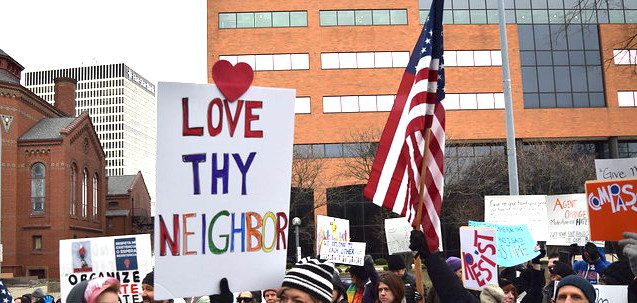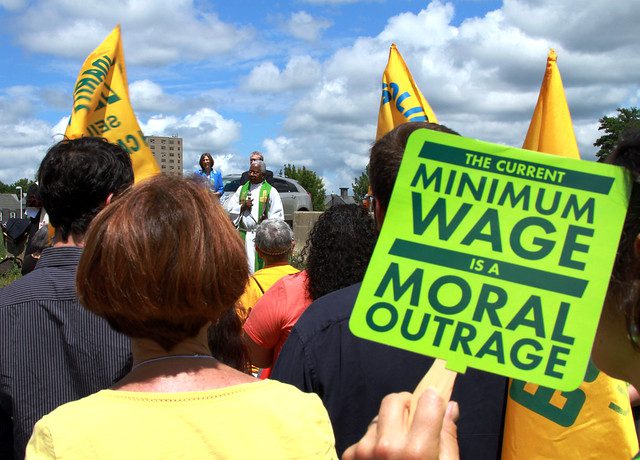
‘Colour in the City,’ by Jocelyn Kinghorn via flickr, CC BY-SA 2.0
The United States is not the only place in the world facing a housing crisis, but some other places are even clearer that their governments ought to be doing something about it. In the U.K., the National Housing Federation has said the national housing crisis is “at the top of politicians’ agendas, no matter what party they belong to,” and there’s pushback that a plan to build 25,000 new homes is not ambitious enough. Meanwhile in New Zealand, Housing Minister Phil Twyford said he wouldn’t support “state-sponsored gentrification” and that social housing developments should be built in every community. We love the sentiment, but then most recently he said Aucklanders who don’t want state or affordable housing nearby should leave the city, which seems kind of opposite to the results he wants. We kind of wish he’d ended that sentence with “just suck it up.”
If when you think of bees (and where they are), you picture a wide-open countryside or a well-tended garden, you may need to think again. Entomologists are finding that these very important pollinators actually prefer the biodiversity present in unkempt and neglected natural spaces, which in our modern world are more likely to be found on urban vacant lots than the manicured lawns of suburbia. This knowledge has the potential to help keep more bees off the endangered species lists, as well as the humans that depend on them.
Though it’s just hitting some people’s radar after the fight over automatic upzoning around transit stops in California, it’s no secret that without strong affordability protections, transit-oriented development can cause “transit-oriented gentrification,” ironically pushing transit’s most loyal customers beyond the reach of stops. While there’s no substitute for permanent affordability, and wide enough transit coverage that being near a stop is not a luxury, it could be that fare-free transit could take the sting out a little bit, while providing a host of other benefits.
This article in LA Progressive may help to expand your thinking on the topic of homelessness and food, which is about more than just finding one’s next meal. Many things you might not think of—storage, safety, hygiene, unhealthy food’s effect on chronic disease—are all touched on in this piece.
Working the problem: Yale Law graduate Thomas Scott-Railton has proposed a way to change the incentives around school segregation—change college admissions policies to include preferences for students from schools with at least a certain percentage of low-income students. This is, in essence, trying to put the ideas of Sheryl Cashin, as she described in her book Place Not Race, into a specific, simple solution. The idea is to overcome some of the fear more well-off parents have about lower average test scores in economically integrated schools, changing the incentives in favor of integration. This seems like the right direction to be thinking, though it won’t likely be enough on its own. For example, CityLab notes that a preference for at least 40 percent low-income students won’t directly help schools that are over 90 percent families in poverty. We’d add that integration in the same school does not automatically get rid of race and class based inequalities, and if the admissions policies only look at high schools, the younger grades may not be affected. Nonetheless, looking at the education system as a whole and the inequality-reinforcing incentives built into it seems like a fruitful place to focus. Colleges: get on that?
A D.C. museum’s exhibition, called Right to the City, chronicles the decades of organizing and resistance by D.C. residents against the forces of displacement—from the late 1940s and the government’s Urban Renewal projects devastating effect on communities to today’s luxury housing development in working class neighborhoods. It is on view until 2020, so the next time you’re in D.C., check it out.
HANDS, a CDC Shelterforce spun off back in the 1980s in Orange, New Jersey, celebrated the opening of its Hat City Lofts, an adaptive reuse of the Berg Hat Factory and named for the city’s past as the nation’s hat making capital. The three-building complex is a mix of affordable loft condominiums and arts-related commercial space. “Today the Valley, and Hat City Lofts are places where artists, makers, entrepreneurs, and residents from around the world build homes, businesses and community,” says HANDS Executive Director Luther Flurry.
The factors that contribute to health are complex, and it’s not so easy to find data that links health to what’s driving it. It’s not that the data isn’t there; it’s just not organized in one place. The Department of Population Health at the NYU School of Medicine hopes to change that with its City Health Dashboard, a database that “brings together city-level and neighborhood-level numbers related to not only health but also its upstream and downstream factors—such as employment, housing, and chronic absenteeism from school,” according to Next City. If you’re interested in more tools like this, make sure you check out our compilation of health-related resources to drill down into specific social determinants of health, collect data, and track outcomes.
The new mayor of Minneapolis has proposed a $50 million housing plan that he hopes will create a more racially and economically integrated city. The funding could be used to preserve naturally occurring affordable housing, provide down-payment assistance for low-income homeowners, reduce property taxes for apartment buildings that include affordable units, and more. What do you think of the plan?
Chicago typically leans left, but conservative groups are trying to change the tide by exploiting fears about affordable housing in the city, according to this ProPublica piece. “Right-leaning groups have moved money through nonprofits and political action committees—and publicized candidates and ideas on their own news sites—to advance their agendas.”





Comments